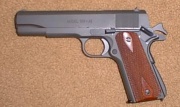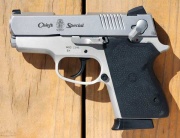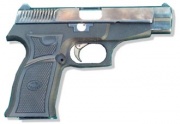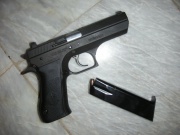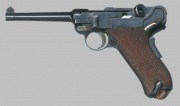Semi-automatic pistol
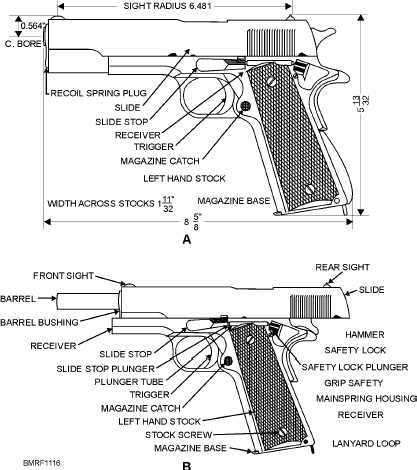
A semi-automatic pistol is a type of handgun that can be fired in semi-automatic mode, firing one cartridge for each pull of the trigger. This type of firearm uses a single chamber and a single barrel, which remain in a fixed linear orientation relative to each other while being fired and reloaded semi-automatically. Some terms that have been, or still are, used as synonyms for semi-automatic pistol are automatic pistol, autopistol, self-loading pistol, and selfloader.
Contents |
[edit] Overview
A semi-automatic pistol functions by using the energy from the recoil of a single round of ammunition to extract and eject a fired cartridge from the pistol's chamber and load an unfired round from a magazine into the chamber for the next shot.
Most types of semi-automatic pistols rely on a removable magazine for supplying new ammunition to reload the chamber to be able to fire the gun again. The removable magazine is typically located inside a hand grip. Typically, the first round is manually loaded into the chamber by pulling back and releasing ("racking") the slide mechanism, after which the recoil operation of the handgun when fired automatically extracts, ejects, and reloads the chamber. This mode of operation generally allows for faster reloading and storing a larger number of cartridges than a revolver, although semi-automatic pistols are potentially more prone to malfunctions than revolvers due to their more complex design and mechanism.
Some modern semi-automatic pistols are double action only (DAO); that is, once a round is chambered, each trigger pull will cock the hammer, striker, or firing pin, and will additionally release the same to fire a cartridge in one continuous motion. Each pull of the trigger on a DAO semi-automatic pistol requires the same amount of pressure. The Kel-Tec P-32 is an example of a DAO action. DAO semi-automatic pistols are most generally recommended only in the smaller, self-defense, concealable pistols, rather than in target or hunting pistols (a notable exception being Glock-brand competition pistols such as the G34 and G35 which are DAO, yet designed with low-strength sear connectors resulting in lightened trigger pulls to improve a shooter's accuracy).
Standard modern semi-automatic pistols are usually double action (DA), also sometimes known as double-action/single-action (DA/SA.) In this design, the hammer or striker may be either thumb-cocked or activated by pulling the trigger when firing the first shot. The hammer or striker is re-cocked automatically during each firing cycle. In double-action (DA) pistols, the first pull of the trigger requires roughly twice as much pressure as subsequent firings, since the first pull of the trigger also cocks the hammer (if not already cocked by hand). The Beretta 92F/FS, a full-sized, service, semi-automatic pistol is an example of this style of action. A common mode of carry for DA semi-automatic pistols is with the magazine full, a round chambered, and the gun holstered and uncocked with the external safety unengaged or off.
An alternative carry mode, and the mode often used by single-action pistols, is with the magazine partially full, a round chambered, and the gun holstered, and cocked with the external safety engaged or on. In contrast, a single-action (SA), semi-automatic pistol must be cocked by first operating the slide or bolt, or, if a round is already chambered, by cocking the hammer manually. The famed Colt M1911 is an example of this style of action. All SA semi-automatic pistols exhibit this feature, and automatically cock the hammer when the slide is first "racked" to chamber a round.
The normal mode of carrying an SA semi-automatic pistol is Condition 1, popularly known as cocked and locked (see photo of Springfield Armory M1911A1 above). Condition 1 (a term popularized by Colonel Jeff Cooper) refers to having the magazine full, a round chambered, the hammer fully cocked, and the thumb safety engaged or on, at least for right-handed users. For many single-action, semi-automatic pistols, this procedure works well only for right-handed users, as the thumb safety is located on the left side of pistol and is easily accessible only for those who are holding the pistol in the right hand.
On many SA semi-automatic pistols, there is also a hammer position known as "half-cocked.". Squeezing the trigger will not fire the gun when it is in the half-cocked position, and neither will dropping the gun in this state cause an accidental discharge. During WWII in the Pacific Theater, an unofficial and unapproved carry mode for the SA M1911 by left-handed US soldiers in combat was carrying the gun with the magazine full, a round chambered, the action in half-cocked position, and the thumb safety (accessible only to right-handed users) positioned in the off (or ready-to-fire) mode. The primary advantage of the half-cocked position versus the uncocked position in that particular scenario was added sound suppression, a secondary advantage being the avoidance of accidental discharges if the gun were accidentally dropped.
Cocking the gun from uncocked to fully cocked was much noisier than turning the safety off for right-handed users, or cocking the gun from half cocked to fully cocked for left-handed users. In general, however, single-action, semi-automatic pistols should never be carried cocked with the safety off. Many modern SA semi-automatic pistols have had their safety mechanisms redesigned to provide a thumb safety on both sides of the pistol, thereby better meeting the needs of left-handed as well as right-handed users.
There also have been notable semi-automatic pistol designs with different traits than those generally described here, including those with a magazine fed with a stripper clip, and those with non-removable (sometimes called blind-box) magazines. These designs are rarely used in modern semi-automatic pistols. The Model C96, or "Broomhandle" Mauser, in its original configuration, has a fixed, non-removable magazine located in front of the trigger, which is loaded directly through the breech from the top of the pistol, in contrast to most contemporary pistol designs.
Semi-automatic pistols utilize one firing chamber that remains fixed in a constant linear position relative to the gun barrel. In contrast, although double-action revolvers can also be fired semi-automatically, their rounds are not fired from a single chamber, but rather are fired from each of 4 to 10 chambers, with 6 chambers being the most common, that are rotated into linear alignment with the barrel's position in turn just prior for each shot fired.
The language surrounding automatic, semi-automatic, self-loading, etc., often causes confusion due to differences in technical usage between different countries and differences in popular usage. For example, an automatic pistol technically refers to a machine pistol, although in popular American usage it is also used as a synonym for a semi-automatic pistol. In the case of pistols, an 'automatic pistol', a 'semi-automatic pistol', or a 'self-loading pistol', all usually imply a handgun that is semi-automatic, self-loading, and magazine-fed with a magazine that is removable, producing one shot fired for each trigger pull. The term pistol may refer to handguns in general, or may be used to differentiate (semi-automatic) pistols from revolvers.
[edit] Technology
A self-loading pistol reloads the chamber with a new round automatically each time the weapon is fired, without additional action being required by the user. For a semi-automatic pistol, this is typically accomplished by recoil operation. (For a machine pistol, in contrast, this can be accomplished by recoil operation, or, less commonly, by harnessing gases produced when the gun is fired. See the Desert Eagle for an example of a semi-automatic pistol that does siphon off some of the gases instead of relying on short recoil operation. See Gas-Operated article for details on gas operation of firearms. A semi-automatic pistol will fire only one shot per trigger pull, in contrast to a "fully automatic" or machine pistol, which continues to fire as long as the trigger is held or until all rounds have been fired.
While both types of weapons operate on the same principles, fully automatic weapons must be built more ruggedly to accommodate the heat and stress caused by rapid firing, and it can be difficult (and illegal in most countries) to convert a semi-automatic pistol into a fully automatic mode of fire. A selective fire action pistol, though, can be converted back and forth with a simple flick of a switch, and often includes burst mode. Selective fire weapons are generally used by specialized law enforcement and security personnel, and are not generally available to civilians except (in the US) for those civilians holding a Class III Federal firearms license. The Mauser Model 712 "Schnellfeuer" (German for "rapid fire"), a later variant of the Mauser C96 pistol mentioned above, is a prolific example of a true machine pistol.
[edit] Actions: blowback vs. locked breech
Self-loading automatic pistols can be divided into "blowback" and "locked breech" categories according to their principle of operation. This classification roughly divides the operation into those specifically suitable for small-caliber versus large-caliber semi-automatic pistols.
In blowback semi-automatic pistols, typically .380 caliber (sometimes known as 9 mm Kurz, i.e., 9 mm Short) or smaller, the barrel is fixed to the frame and the slide or bolt, in its foremost position, is held against the barrel only by the force of the recoil spring. The slide starts to move backwards immediately upon the gun's being fired, as there is no locking action to hold the breech block and slide locked with the barrel, even temporarily. At the appropriate point in the rearward motion, extraction and ejection of the fired brass of the cartridge are accomplished, and the used brass is typically ejected to the right of the pistol.
During the motion rearwards, the striker, hammer, or firing pin may be re-cocked. A spring, called a recoil spring, slows the movement of the slide as it is compressed. When the slide reaches the rear of its travel, the recoil spring is fully compressed (if not, the pistol may suffer a failure, called a "jam"). The slide begins to move forward under the force of the spring, stripping a new cartridge from the magazine and pushing the new cartridge into the chamber. Upon the slide's return to its fully forward position, the pistol is ready once more to be fired by squeezing the trigger.
The mass of the slide of a blowback design must be sufficient to hold the breech closed until the bullet exits the barrel, and the remaining pressure drops to a safe level. A cartridge with too high a pressure, or a slide with too little mass can cause the cartridge case to extract too early, causing a case rupture. This generally limits blowback pistol designs to calibers less powerful than 9x19mm (blowback action is common for pistols chambered in .22LR), though there are variants of the blowback design that further delay the slide's rearward travel without locking the breech, known as delayed blowback. These actions allow the use of larger cartridges and were popular in early machine guns.
By contrast, in a locked-breech design (typically 9 mm or larger) the barrel is temporarily locked to the slide. The most common locked-breech type is the short-recoil design. In a short-recoil pistol, the slide and barrel recoil together a short distance while locked together, until the cartridge-firing chamber pressure has dropped to a safe level. After sufficient travel to allow the bullet to exit and the pressure to drop, the barrel then unlocks from the slide, and the barrel's rearward motion is stopped while the slide continues its reaward travel. The ejection and loading of the new cartridge are similar to that in a blowback pistol. After the slide seats the new round into the chamber, the barrel begins to move forward with the slide, locking into place, at which point the cycle is complete.
Some cartridges, such as the .44 Magnum, are so powerful that the spring required to slow the recoiling barrel and slide becomes very difficult to compress by hand, making it very difficult for most people to load the pistol. Magnum cartridges are often found chambered in pistols that use a gas-operated design, more commonly found in a rifle. One example of a gas-operated pistol is the Desert Eagle chambered for the .50AE Magnum-inspired autoloader round.
Blowback pistols are simpler to make and thus cheaper, but the blowback mechanism can practically be used only with low-pressure cartridges of relatively low power, typically .380 ACP caliber or smaller. With caliber 9 x 19 mm or larger, the slide mass starts to become excessive, and therefore few blowback handguns in such calibers exist; the primary exceptions are simple, inexpensive guns such as those made by Hi-Point Firearms, and semi-automatic versions of blowback submachine guns. In contrast, locked-breech mechanisms are used for some .32, .380 pistols; most 9 mm pistols; and nearly all pistols of .40, .45, and larger calibers. This keeps the mass of the slide lower, and the overall size of the pistol more manageable.
[edit] Trigger mechanisms
Another differing point among semi-automatic pistols are their trigger and ignition systems. Early designs used so-called "single-action" mechanisms whereby a hammer had to be manually cocked to fire the first shot (though for subsequent shots the hammer was cocked by the energy associated with the recoil from the preceding shot). This was usually somewhat mitigated, however, as racking the slide to chamber the first round would initially cock the hammer. Then, when the trigger was pulled, the hammer would hit the firing pin which would then strike the primer of the round in the chamber and fire the pistol, and subsequently the semi-automatic extraction, ejection, and re-loading functions as well as subsequent cocking of the hammer would be performed without any action on the part of the user. For carry, a round would be chambered, and the hammer would simply be blocked in its cocked position with a manual safety.
These early designs could not prevent the pistol from firing if dropped on a hard surface on the muzzle of the barrel, as the firing pin was only held in place by a spring. There was also a (very rare) risk that such a pistol would fire in fully automatic mode if the sear which holds the cocked hammer in place became worn with age, or if the firing pin becamed jammed in the breechblock. In that case, the pistol would start firing upon squeezing the trigger, and would only stop firing when out of ammunition, posing a great risk for its user. There was also a rare risk that a slamfire could occur, when chambering a round to load the gun if the firing pin spring was weak, such that simply loading the gun could cause it to accidentally discharge (such a malfunction similarly introduces the risk of an automatic-fire situation). The introduction of drop safeties as well as the development of high-hardness steel alloys reduced the risk of most such occurrences to effectively zero, though pistols must be regularly inspected for signs of wear, and worn parts replaced, to ensure continued reliable action.
Later designs introduced "double action" mechanisms, which eliminated the need to cock the hammer manually first to fire the pistol. Instead, the hammer was cocked as the trigger was initially pulled. This first trigger pull in double-action mode (uncocked hammer) was heavier than when in single-action mode. After the first shot, the pistol reverted to single-action mode because the rearward motion of the slide (which cycles the pistol) would also cock the hammer for the next round; the trigger pull weight in single-action mode is usually half of what it is in double-action mode. If the particular pistol has a manual safety, when it is engaged it will usually (depending on the design) de-cock the hammer and return the semi-automatic pistol to double-action mode.
There are also "double action only" mechanism designs in which there is no single-action mode, as the hammer, firing pin, or striker cannot stay in a cocked position. In most double-action-only designs, the trigger is disconnected while the hammer block safety is applied. Note that some double-action pistols lack the firing pin safety, and some even lack any external manual safety, depending instead on a combination of the double-action-only mechanism with an internal hammerblock mechanism to prevent the firing pin from hitting the chambered cartridge in the event of accidentally dropping the gun on its muzzle. Such designs can be safely carried with a full magazine, and with a round in the chamber, and still remain safe even if accidentally dropped onto the muzzle. In many ways, such double-action-only mechanism semi-automatic pistols function for carry much like a revolver, which typically is loaded in only 5 cylinders out of 6, with the hammer down on an empty cylinder to prevent an accidental discharge if dropped.
Some double-action-only mechanism designs are sometimes also called "safe action" or "semi-double action" mechanism designs, implying there is no hammer, and when one pulls the trigger one fully cocks the striker or firing pin until it releases and fires the pistol, all in one rather long trigger pull. When the trigger is in ready-to-fire position, the striker is blocked so that the semi-automatic pistol cannot fire if dropped.
[edit] History
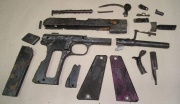
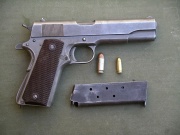
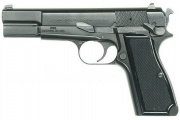
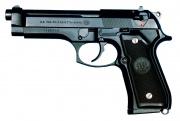
After Hiram Maxim introduced his recoil-powered machine gun in 1883, several gunsmiths set out to apply the same principles to handguns, including Maxim. Maxim's designs for smaller firearms using his recoil-powered ideas never went into production.
In the 1880s, other designers worked on self-loading designs. The first model to gain any commercial success was the Hugo Borchardt-designed self-loading Borchardt C-93 semi-automatic pistol, which was designed in 1893 and made its public appearance in 1894. Borchardt invented the C-93 mechanism, but it was based in large part upon Maxim's toggle-lock principle. The C-93 featured a clever locking mechanism modeled after the human knee joint in which the mechanical joint is called a knee, or in German Kniegelenk (knee joint). The C-93 proved mechanically reliable, but was too large and bulky to receive widespread acceptance. Equipped with a screw-on wooden stock, the C-93 served well in small pistol carbines, however. Borchardt also developed the 7.65 x 25 mm Borchardt cartridge, around which the C-93 was built.
In 1896, Paul Mauser introduced his first model of the famous Mauser "Broomhandle" semi-automatic pistol, the C96. Using the powerful 7.63 mm bottle-necked cartridge originally designed by Borchardt, the Mauser was the first self-loading pistol used extensively in battle, notably the South African War of 1899-1902. These pistols were made in 7.63 x 25 mm Mauser, but some models were eventually made in 9 x 19 mm Parabellum (9 x 19 mm Luger) and a small number in .45 ACP.
In the United States in 1896, the first American gun designer to develop self-loading semi-automatic pistols was John Browning, whose models were manufactured by Colt in the US, and by the Belgian firm of Fabrique Nationale (FN) in Europe. Like Luger's work conducted around the same time in Germany, Browning's first successful design was in 7.65 mm caliber, the Browning M1900. Browning also devised a slightly different 7.65 mm Browning (.32 Auto, 7.65x17mm SR) cartridge for his .32 caliber semi-automatic pistol that differed from Luger's 7.65 mm Luger (.30 Luger, 7.65 x 21 mm) cartridge. Browning also designed .25 ACP, .380 ACP, and .45 ACP cartridges in addition to .32 ACP cartridges for his semi-automatic pistol designs.
He also created the locked-breech action now commonly used by nearly all heavy-caliber semi-automatic pistols, and designed the .45 ACP Colt M1911 single-action semi-automatic pistol, which was adopted by the US military in 1911 (hence the Model 1911 designation) and which remained in service for over 70 years. The Model 1911 is still in active use with some US Special Forces and Marine Corps units.
Browning also co-designed the FN Browning Hi-Power, announced in 1922, during the last years of his life, working on this design until his death in 1926. It was a 9 mm Para semi-automatic pistol and was the first high-capacity, semi-automatic pistol design to feature a double column magazine capable of holding 13 rounds (plus one chambered) in place of the single column magazine that Browning had favored in designing the earlier .45 ACP Colt M1911. (The earlier, single-column magazine design is still used to today, however, especially for deep-concealment semi-automatic pistols such as the Kel-Tec P-32.)
The next notable design was the 7.65 mm Luger by Georg Luger, which although successful in its function, nonetheless failed to have adequate stopping power and failed to win widespread acceptance. In 1902, Georg Luger's subsequent and similar 9 mm Luger Parabellum (9 x 19 mm) Pistole Parabellum design overcame the problem of inadequate stopping power and featured a greatly improved Borchardt-type Kniegelenk ("knee-joint") locking mechanism. Unlike Browning's locked-breech design, the barrel in a Kniegelenk design does not tip up and down while the gun is fired, thereby theoretically improving shooting accuracy. Luger's 9mm Pistole Parabellum design was adopted by the German military and served as their standard sidearm during World War I. During World War II, Germany was the first nation to adopt a double-action pistol, the Walther P38 which could be carried loaded (with a cartridge chambered) and ready to fire without the risk of an accidental discharge if dropped. The P38 likewise used Luger's 9 mm Parabellum (9 mm Luger) cartridge.
During World War II, the only major powers to still use military revolvers as sidearms were Britain, the Soviet Union, and the United States. Though the British firm Webley and Scott had developed several adequate self-loading pistols, one of which was adopted by the British Police in 1911 and by the Royal Navy and Royal Marines before the First World War, their trusty revolvers were generally preferred by most British military. In the Soviet Union, the TT pistol replaced the Nagant M1895 revolvers during the war. In the United States, though, the Colt M1911A1 semi-automatic single-action pistol was adopted as the standard military sidearm. Both Colt and Smith & Wesson produced revolvers chambered for the same .45 ACP pistol ammunition used in the M1911A1, because of the great demand for handguns and the need to adopt a common cartridge for use among semi-automatic pistols and revolvers.
After World War II, most nations eventually adopted 9 mm Luger (9mm Parabellum) caliber pistols employing Browning's locked-breech design for their standard-issue military pistols. The most popular early choice was the previously mentioned FN Browning Hi-Power, which was the first high-capacity pistol; another popular model was the locked-breech Walther P38 because of its many modern safety features. The current U.S. military sidearm is a variant of the Beretta 92F/FS.
In 1971, Smith & Wesson was the first company to offer a safe double-action, high-capacity pistol with its Model 59. CZ launched its CZ-75 in 1975. Beretta introduced its Beretta 92 in 1976. Glock introduced the groundbreaking Glock 17 in 1982, and SIG-Sauer introduced its model SIG P226 in 1983. In the early 90s, Heckler & Koch combined what they thought were the most desirable attributes of semi-autos in their pistol, the HK USP. In 1995, Kel-Tec introduced their first compact 9mm Parabellum pistol, the Kel-Tec P11, designed for concealed carry. In 1999, Kel-Tec introduced their extremely popular .32 ACP P-32 for deeply concealed carry. Both of the Kel-Tec pistols are double-action-only (DAO) designs.
After the Second World War, the almost universal trend has been for self-loading, semi-automatic pistols to replace revolvers for military use, although the transition has been slower among police and civilian use. Today, revolvers are mainly used for civilian self-defense, hunting, plinking, and target practice. Semi-automatic pistols, though, are becoming by far the most popular for deeply concealed carry by licensed civilians, for use as primary handguns for police and military use, for use as backup guns for police use, and for use where the 5 or 6 shots of a revolver are deemed inadequate.
[edit] See also
[edit] References
